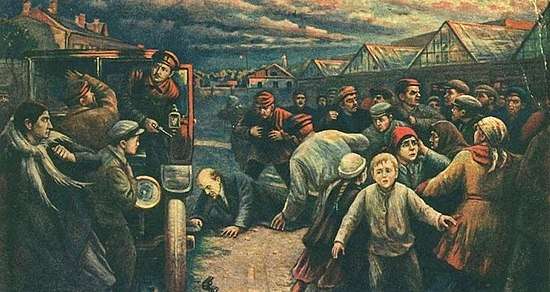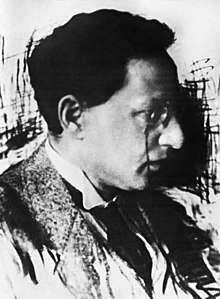Fanny Kaplan
Fanny Efimovna Kaplan (Russian: Фа́нни Ефи́мовна Капла́н; real name Feiga Haimovna Roytblat, Фейга Хаимовна Ройтблат; February 10, 1890 – September 3, 1918) was a member of the Socialist Revolutionary Party. Kaplan allegedly shot Vladimir Lenin.
Fanny Kaplan | |
|---|---|
 | |
| Born | Feiga Haimovna Roytblat February 10, 1890 |
| Died | September 3, 1918 (aged 28) Moscow, Russian SFSR |
As a member of the Socialist Revolutionaries (SRs), Kaplan viewed Lenin as a "traitor to the revolution" when the Bolsheviks banned her party. On 30 August 1918, she approached Lenin as he was leaving a Moscow factory, and fired three shots, badly injuring him. Interrogated by the Cheka, she refused to name any accomplices, and was shot on 3 September. The Kaplan attempt and the Moisei Uritsky assassination provoked the Soviet government to reinstitute the death penalty after its abolition on October 28th, 1917.
Biography
Relatively little is known for certain about Kaplan's background. She was born into a Jewish family, as one of seven children. There has been confusion about her full name. Vera Figner (in her memoirs, At Women's Katorga), stated that Kaplan's original name was Feiga Khaimovna Roytblat-Kaplan (Фейга Хаимовна Ройтблат-Каплан). However, other sources have stated that her original family name was Roytman (Ройтман) – corresponding to the common German/Yiddish surname Reutemann. She was also sometimes known by the given name Dora.[1]
She became a political revolutionary at an early age and joined a socialist group, the Socialist Revolutionaries (SRs). In 1906, when she was 16 years old, Kaplan was arrested in Kiev over her involvement in a terrorist bomb plot, and committed for life to the katorga (a hard-labor prison camp). She served in the Maltsev and Akatuy prisons of Nerchinsk katorga, Siberia, where she lost her sight (partially restored later). She was kept in the Maltzevskaya prison, where she was severely caned on her bare body as disciplinary corporal punishment.[2] Fully undressed corporal punishment was not usual for political prisoners at that time. She was released on March 3, 1917, after the February Revolution overthrew the imperial government. As a result of her imprisonment, Kaplan suffered from continuous headaches and periods of blindness.
Kaplan became disillusioned with Lenin some time around 1917, as a result of conflict between the SRs and Bolsheviks.[3] The Bolsheviks had strong support in the soviets; however, in elections to a competing body, the Constituent Assembly, the Bolsheviks failed to win a majority in the November 1917 elections and a Socialist Revolutionary was elected president in January 1918. The Bolsheviks, favoring soviets, ordered the Constituent Assembly to be dissolved. By August 1918 conflicts between the Bolsheviks and their political opponents had led to the banning of most other influential parties - most recently, of the Left Socialist Revolutionaries (Left SRs), who had been the Bolsheviks' principal coalition partner for some time, but had organized the Left SR uprising in July because of their opposition to the Treaty of Brest-Litovsk. Kaplan decided to assassinate Lenin because she considered him "a traitor to the Revolution".[4]
Assassination attempt

On 30 August 1918, Lenin spoke at the Hammer and Sickle, an arms factory in south Moscow.[5] As Lenin left the building and before he entered his car, Kaplan called out to him. When Lenin turned towards her, she fired three shots with a Browning pistol.[1] One bullet passed through Lenin's coat, the other two struck him: one passing through his neck, puncturing part of his left lung, and stopping near his right collarbone; the other lodging in his left shoulder.[1][6]
Lenin was taken back to his living quarters at the Kremlin. He feared there might be other plotters planning to kill him and refused to leave the security of the Kremlin to seek medical attention. Doctors were brought in to treat him but were unable to remove the bullets outside of a hospital. Despite the severity of his injuries, Lenin survived. However, Lenin's health never fully recovered from the attack and it is believed[7] the shooting contributed to the strokes that incapacitated and eventually killed him in 1924.
Execution
Kaplan was taken into custody and interrogated by the Cheka. She made the following statement:
My name is Fanya Kaplan. Today I shot Lenin. I did it on my own. I will not say from whom I obtained my revolver. I will give no details. I had resolved to kill Lenin long ago. I consider him a traitor to the Revolution. I was exiled to Akatui for participating in an assassination attempt against a Tsarist official in Kiev. I spent 11 years at hard labour. After the Revolution, I was freed. I favoured the Constituent Assembly and am still for it.[8]
When it became clear that Kaplan would not implicate any accomplices, she was executed in Alexander Garden, on September 3, 1918 with a bullet to the back of the head.[1] Her corpse was bundled into a barrel, and set alight. The order came from Yakov Sverdlov who, just six weeks before, had ordered the execution of the tsar and his family.
Culpability
Some historians such as Arkady Vaksberg and Donald Rayfield have questioned the actual role of Kaplan in the assassination attempt.[9] Vaksberg states that Lidia Konopleva, another SR, was the culprit, believing it would be all too comforting that Lenin narrowly avoided being assassinated by a woman whose personality is so far from the stereotype of a national hero.[10] In particular, it is suggested that she was working on behalf of others and after her arrest assumed sole responsibility. The main argument put forth in this and other versions is her near-blindness. Another argument points to the contradiction between the official Soviet account (which states that angry workers who witnessed the event immediately seized Kaplan) and official documents, in particular a radiogram by Yakov Peters, which mentions the arrest of several suspects.
Legacy

In the official announcement of the assassination attempt, Kaplan was declared a Right Eser (Right SR). Moisei Uritsky, People's Commissar for Internal Affairs in the Northern Region and head of the Cheka in Petrograd, had been assassinated nearly two weeks prior to the attack on Lenin. While the Cheka did not find any evidence linking the two events, their co-occurrence appeared significant in the overall context of the intensifying civil war. The Bolshevik reaction was an abrupt escalation in the persecution of their opponents.
An official decree on Red Terror was issued only hours after the Kaplan shooting, calling for all-out struggle against enemies of the revolution. In the next few months, about 800 Right SRs and other political opponents of Bolsheviks were executed. During the first year, the scope of the Red Terror expanded significantly.
Fictional
The event is portrayed in Reilly, Ace of Spies, a 1983 British TV series. Kaplan has been the subject of or character in several plays including (Fanny Kaplan by Venedikt Yerofeyev; Kill me, o my beloved! by Elena Isaeva) and books (Europe Central by William T. Vollmann).
See also
References
- How Did They Die? by Norman and Betty Donaldson, p. 221.
- Школьник, Мария ЖИЗНЬ БЫВШЕЙ ТЕРРОРИСТКИ, ГЛАВА VI Archived 2009-01-16 at the Wayback Machine
- Kowalski, Ludwik (2008). Hell on Earth – Brutality and Violence Under the Stalinist Regime. American Academy of Arts and Sciences. p. Glossary. ISBN 978-1-60047232-9.
- "1918: Fanya Kaplan, Lenin's would-be assassin". ExecutedToday.com. September 3, 2009.
- Moscow: A Cultural History by Caroline Brooke, Oxford University Press, p. 74
- Partly confirmed in Top Five Assassination Attempts - Number Four, Lenin 1918 (link), Military History Monthly magazine, published 18 November 2014, accessed 20 November 2014.
- "'He doesn't bother anybody. Let him stay': MPs reject idea of removing Lenin's body from mausoleum". RT. 2019-01-21.
- "Fanya Kaplan". Spartacus Educational.
- Stalin and His Hangmen: The Tyrant and Those Who Killed for Him by Donald Rayfield, p. 78.
- Stalin and His Hangmen: The Tyrant and Those Who Killed for Him by Donald Rayfield, p. 79.
- Venedikt Erofeev, 'Fanny Kaplan' (in Russian)
- Elena Isaeva, 'Kill me, o my beloved' (in Russian)
Further reading
- Yuri Felshtinsky, Lenin and His Comrades (New York: Enigma Books, 2010), ISBN 978-1-929631-95-7.
External links
- Fanya Kaplan on Spartacus
- Fanya Kaplan Biography at J-Grit: The Internet Index of Tough Jews
- The location in Moscow where Fanny Kaplan shot Lenin